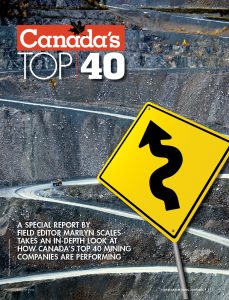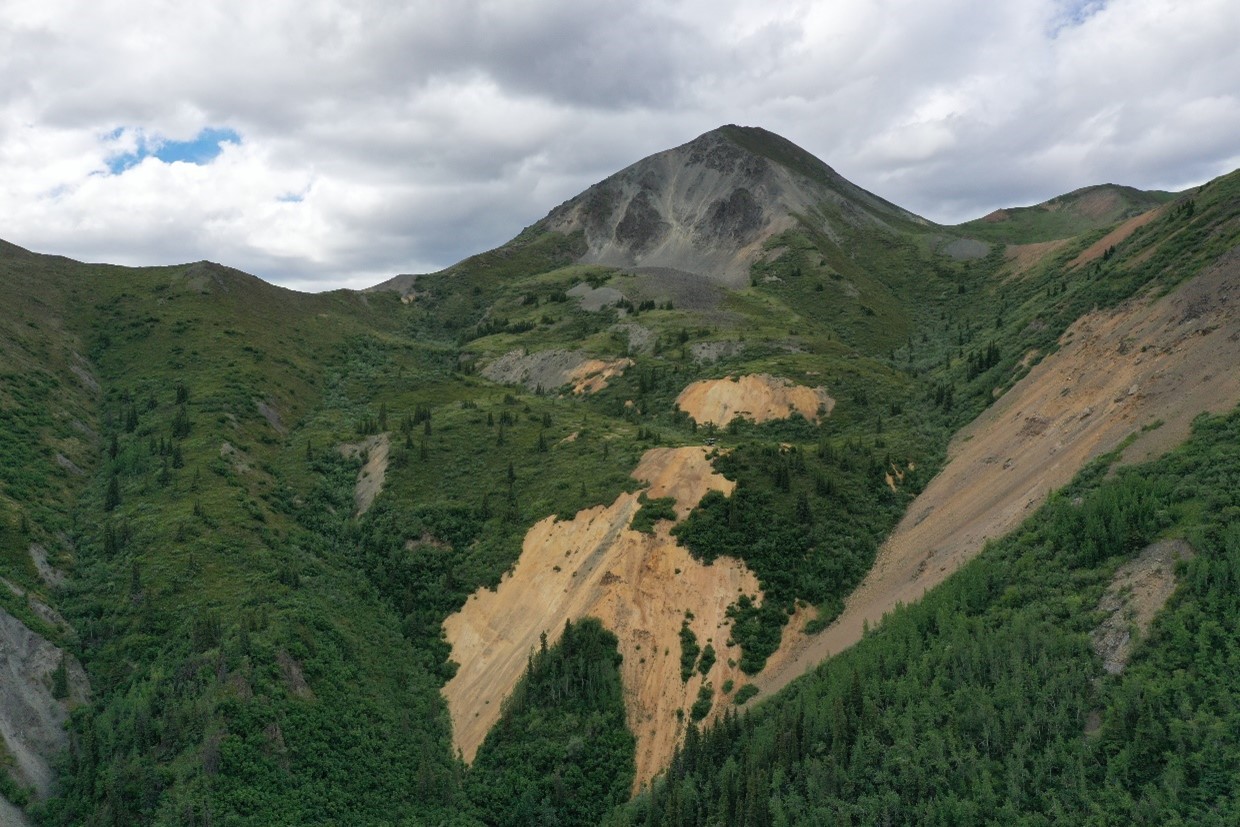Canada’s Top 40: 2016 edition
Another rough year sees lowered earnings for Top 40
Canadian miners have weathered another tough year as commodity prices stayed stubbornly in the doldrums throughout 2015.
Almost without exception mineral prices fell for the second straight year. Gold, copper, nickel, zinc, iron ore, coal, uranium, potash – all down. The World Bank’s Metals and Minerals Index was 66.9 for 2015 (using 2010 prices equal to 100), down from 84.8 in 2014 and 90.8 in 2013.
 Despite the drop in fertilizer prices, Agrium once again heads CMJ’s list of Top 40 mining companies with gross revenues of $18.92 billion. That is a massive amount of revenue compared to Potash Corp. of Saskatchewan that finished fifth with revenues of $8.03 billion.
Despite the drop in fertilizer prices, Agrium once again heads CMJ’s list of Top 40 mining companies with gross revenues of $18.92 billion. That is a massive amount of revenue compared to Potash Corp. of Saskatchewan that finished fifth with revenues of $8.03 billion.
Filling the spaces between first and fifth are Barrick Gold, second with revenues of $11.55 billion; Suncor Energy’s oil sands business, third with $9.36 billion; and Teck Resources, fourth with $8.26 billion.
Rounding out the first 10 are Goldcorp ($5.60 billion), Kinross Gold ($3.90 billion), First Quantum Minerals ($3.45 billion), Cameco Corp. ($2.75 billion), and Agnico Eagle Mines ($2.54 billion).
As if to underline the sagging commodities markets, only three of these 10 companies recorded net earnings for 2015 – Agrium ($1.26 billion), Cameco ($344.0 million), and Agnico Eagle ($31.5 million). That’s not much considering the 10 companies had total gross revenues of $74.37 billion and each has assets counted in the tens of billions of dollars. Taking the Top 40 as a whole, only 12 companies managed to post positive earnings last year, compared to last year’s survey when 22 of the Top 40 posted profits.
Kudos to every company that made the Top 40, and a special shout out to Detour Gold, 23rd with revenues of $720.1 million. This is the first time that company has made the list, a special achievement when gold prices fell by almost 9%, taking quite a toll on other miners of the yellow metal. Teranga Gold moved up to the 40th spot from 45 a year ago, and the biggest jump was made by Tahoe Resources, 30 places from the bottom of the Runners-up list to 25th spot last year. Other Runners-up that made their way into the Top 40 were Primero Mining (34th) and Lucara Diamond Corp. (38th).
We also kept track of the 15 companies that almost made the Top 40 list, our Runners-up. The cut-off point was $285 million in revenues. First Majestic Silver came so close with $280.6 million. The Runners-up table is where companies often make their first appearances, and this time there are seven newcomers – Paladin Energy ($255.2 million), Mandalay Resources ($248.8 million), Kirkland Lake Gold ($219.9 million), Banro Corp. ($200.4 million), North American Palladium ($193.6 million), Gran Colombia Gold ($172.5 million), and Silvercorp Metals ($164.4 million). Well done.
Readers may notice some familiar names have disappeared from our survey, usually due to takeovers. One notable omission is Syncrude. Suncor took over Canadian Oil Sands Ltd. thus consolidating its hold on Syncrude, but that meant no 2015 figures were available for Syncrude.
One way to look at the growth of the Canadian mining industry is to rank whether revenues rose or fell year over year. Lundin Mining boosted its revenues by 78.9%, by far the best showing among the Top 40. Growing revenue was a blessing for 17 of the Top 40. Yamana Gold squeaked by with an increase of 0.2%. Then there were those companies that lost revenue in 2015 compared to 2014. New Gold lost the least, a mere 0.6%, and Thompson Creek Metals saw revenue fall 38.1%.
To track the growth of earnings, companies must have earnings, and between last year and 2014 only three of the Top 40 managed to increase their year-over-year earnings. Semafo and Lucara Diamond Corp. did very well with increases of 73.0% and 70.1%, respectively. Agrium recorded a 37.2% boost to net earnings. Among the six other companies that managed to report positive income in both years, the amount was down 15% to 85% in 2015.
And finally, a quick look at how the assets of our Top 40 companies changed last year. If you were one of the 19 primary gold producers on the list, you could have expected your assets to fall in value by 20% or 25%. There were exceptions. Tahoe Resources saw its gold-silver assets grow by 105.3%; commissioning the new Shahuindo mine in Peru certainly helped. Of the larger gold producers, Agnico Eagle had the smallest asset value drop, only 1.9%.
Gold producers weren’t the only ones who suffered asset shrinkage last year. Hudbay Minerals saw a drop of 7.6% despite ramping up the Lalor and Reed mines. Thompson Creek Metals took a whopping 38.1% hit. Sherritt International saw its assets slip 22.6%, an amount more typical of gold miners, not nickel miners.
That’s a lot of bad news for Canadian miners, but some analysts are beginning to talk about a revival of commodity prices, led perhaps by gold this year. But much depends upon economies spread around the globe – China, Brazil, India, the Russian federation. We must wait and see. In the meantime, encourage every Canadian miner you know to work smarter – safely, more productively, manage costs – and stay in business. The tide will eventually turn.
As a post script, let me leave you with these numbers from the world’s five biggest mineral producers: Glencore had revenues of $218.07 billion and lost $10.38 billion. BHP Billiton raked in $57.09 billion and had net earnings of $3.51 billion. Rio Tinto took in $49.61 billion and lost $1.11 billion. Anglo American had revenues of $33.42 billion but lost $7.47 billion. Lastly, Vale reported revenue of $33.31 billion and a net loss of $15.51 billion.
How we choose the Top 40
CMJ scours the internet for the public documents of as many as 100 Canadian mining companies. Miners are deemed “Canadian” if they meet two of the following three criteria: They trade on the Toronto Stock Exchange; they are domiciled in Canada; and they own, operate or have a significant interest in a producing or developing property in Canada. That’s why we don’t include Vale, Glencore, Rio Tinto, etc. If you think your company should have been included and wasn’t, please contact the author, Marilyn Scales by emailing to MScales@CanadianMiningJournal.com. CMJ converts all reporting currencies to Canadian dollars using the Bank of Canada’s average yearly rate. This year the US-to-Canadian rate was US$1:C$1.279, and there were no other currencies used in the public documents examined to create the Top 40 list.
See the tables associated with this article at https://drive.google.com/drive/my-drive





Comments
Ray
How do you give kudos to these top 40, when only 12 could turn a profit? I know the saying, they make it up in volume.